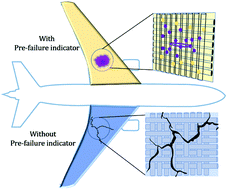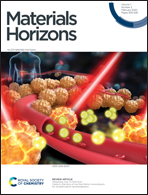Self-reporting mechanochromic coating: a glassfiber reinforced polymer composite that predicts impact induced damage†
Abstract
A major problem of glassfiber reinforced polymer composite (GFRPCs)-based large-scale machinery is its proper damage assessment. Often employed GFRPCs have high endurance; however, their failure is highly unpredictable. This leads to a requirement for cost-effective stress sensors to precisely indicate initial stages of damage and its extent before a malfunction occurs. A failure may originate at arbitrary positions in GFRPCs, and minute differences in the fiber/matrix coupling may eventually develop into the primary point of a failure. In this work 0.5 wt% of a molecular stress-sensitive sensor is embedded in polythiourethane (PTU), reinforced with glassfibers, and unreinforced samples are used as controls. Spiropyran (SP) is used as a self-reporting functional additive. Only the samples with reinforcement behaved like a desirable self-reporter by exposing damage via color change well before any visible cracks appeared. In unreinforced samples, color change and crack formation occurred simultaneously, with descriptive, however not predictive, function. Comparison tests of SP with a different matrix show that the amine-based hardener used to cross-link epoxy resins reacts with the SP molecules, destroying them and thus deactivating their mechanochromic properties. The mechanisms that are responsible for the responses of the PTU/SP composites with and without glassfibers are investigated and discussed.



 Please wait while we load your content...
Please wait while we load your content...